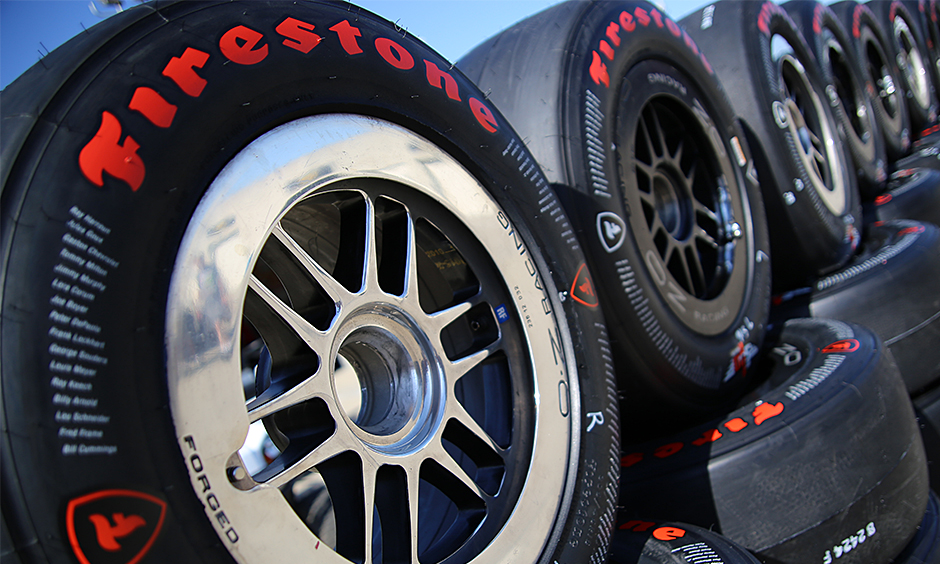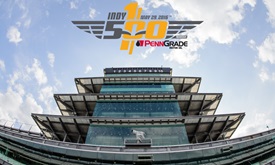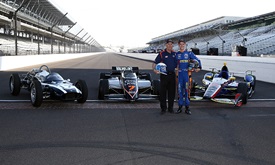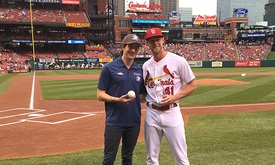Firestone's winning Indianapolis 500 history parallels that of Indianapolis Motor Speedway
MAY 25, 2016
The old proverb may insist that necessity is the mother of all invention, but sometimes innovation is all about simple impatience.
Just ask Mario Andretti, the first driver to use slick tires at the famed Indianapolis Motor Speedway. It happened during a Firestone test in late 1960s when the racing legend didn’t want to sit around and wait for the engineers to carve thin slits called “sipes” into the rubber before he tried a new tire.
“We were running grooved tires at the time, but for the test they would bring slicks and the engineers would come up with different groove patterns and they would cut them into the tires on site,” Andretti said.
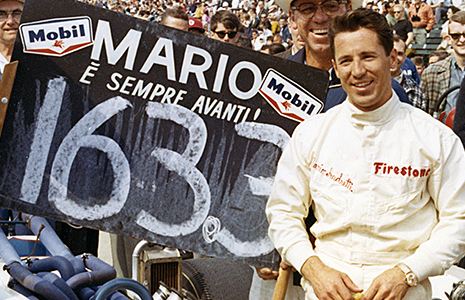 “We were coming down to crunch time and they had one set that had a different construction that they wanted to run, but they had to groove it and I said, 'Let's run it' and I went out and set a record,” laughed Andretti before adding: “That gave us a pretty good signal of the direction we should go.”
“We were coming down to crunch time and they had one set that had a different construction that they wanted to run, but they had to groove it and I said, 'Let's run it' and I went out and set a record,” laughed Andretti before adding: “That gave us a pretty good signal of the direction we should go.”
At the time, engineers hand cut treads into the tires because it was thought it gave the car better grip, especially on a dirty racetrack. Well, at least until Andretti proved them wrong. By 1972, the grooves had disappeared pretty much everywhere in racing on tarmac.
Slicks were just one of many tire innovations to grace the Indianapolis 500 over its first 99 editions as the rubber on the cars went from hard, stiff, bicycle-like offerings in the early days – 34 inches tall and about 4.5 inches wide on Ray Harroun’s 1911 winning Marmon Wasp – to the racetrack-specific, scientific wonders of today.
Tire development followed a similar technical advancement path to the one seen in aerospace. In that industry, the Wright Brothers’ flimsy contraption that made its maiden flight eight years before the first Indy 500 served as the first step toward the technological marvel that was NASA's Space Shuttle, which made its final voyage roughly 100 years later.
“In 1911, in order to qualify and make the first Indy 500 race, the only requirement was that the car had to be able to run 75 miles per hour down the frontstretch,” said Firestone Racing's chief engineer Dale Harrigle.
“They had next to no grip and the cars were extremely heavy as well, so there was actually quite a bit of load on those very small tires.”
Verizon IndyCar Series tire supplier Firestone competed in the first Indianapolis 500 in 1911 and will be there for the 100th on May 29. Other manufacturers in that maiden race were BF Goodrich, Dunlop, and Michelin. Firestone, which left the sport after 1974 and returned in 1995, won the first race with Harroun and added a record 65 more victories in the next 98 editions. Firestone will crown its 67th Indy 500 champion on Sunday, more than all other manufacturers combined.
Tire technology's humble beginnings on the famed 2.5-mile Indianapolis Motor Speedway saw cars use off-the-shelf passenger tires during the first few years of the 500. The 1920s brought significant change when the first dedicated racing rubber made its debut, and the early tire wars began. Introduced in 1925 at the Brickyard, Firestone’s inner-tubed “balloon tire” offered better traction and allowed lower tire pressures, which translated to much better handling.
Early passenger tires frequently failed to reach the 50-mile mark, but the manufactures worked hard to improve reliability and durability in the Indianapolis 500.
In 1964, Indianapolis 500 winner A.J Foyt set a new speed record of 147.35 mph on Firestone tires after becoming the first driver the complete the race at the Brickyard on one set of rubber. In 1969, Andretti won his only 500 after his pit crew could not remove his right rear tire and it went the entire distance.
Ironically, as tire technology advanced in the 1970s and beyond, the compound and construction philosophy went in the direction of multiple tire changes to get the most from the rubber over a shorter distance rather than aiming for long-mileage runs. On the other hand, having a passenger tire go 50,000 miles without the hint of a failure is now expected by consumers.
Andretti said that the tires were improving so fast in the late 1960s that the previous season's car would be 5 to 10 mph faster in the next year just due to advances in rubber. This happened after the still relatively tall and thin tires gave way to the wider, more square – and soon slick – versions familiar today.
“Technology rapidly improved into the 1960s when race tires like we see today were first made with relatively small aspect ratios and very wide,” Harrigle said.
“When we got back into the sport in 1995, the size and shape of the tire was pretty much set, but there was still lots of technology improvement from then to today.”
Along the way, some ideas went extremely well and delivered exceptional results, while getting other innovations ready for “The Greatest Spectacle in Racing” didn't go as smoothly as slicks.
In January 1974, Andretti found himself in the hospital after hitting the wall at about 185 mph in his first radial tire test at California's now-defunct 2.5-mile Ontario Motor Speedway. The 1969 Indy 500 winner tried the new boots as part of Firestone's preparations for the 1974 race.
“They told me at the end of the test that they had a set of radials they wanted me to try, but they asked me to take it easy. I said, 'Take it easy? What?’ Either you are going to go for it or you're not,” Andretti said.
“On the third lap, the whole belt on the right rear came off exiting Turn 2 and I stuck it into the wall backwards. It's the only time I remember being knocked out.”
Radial technology marched on despite Andretti's scare, and they soon become standard issue on all passenger vehicles rolling off the assembly line.
And that's the real reason why Firestone got involved in racing in the first place: learning lessons the company can apply to the fundamental components of its consumer offerings, such as the polymers and the chemicals, that go into the tires.
“Where we really get a benefit from our racing program is in developing new and unique solutions to what we need to do to the race tire that carry over to the passenger tires,” Harrigle said.
"It's very much a science: We have a team of chemists and engineers who work side-by-side and everybody gets come to the racetrack and talk to drivers and the team and we use this as a development tool not only for the chemistry of the tires but also for the engineering that goes into them.”
Photos below provided by IMS Photo and Bridgestone Americas, Inc.


















